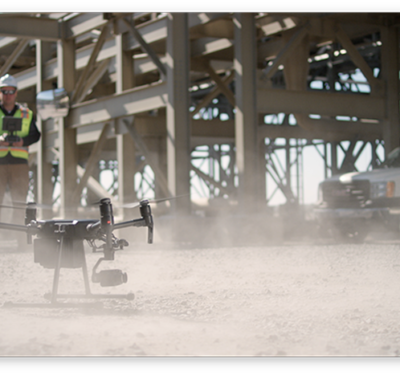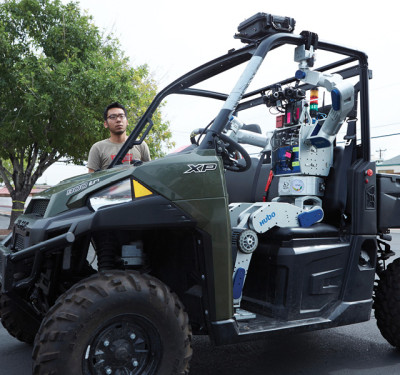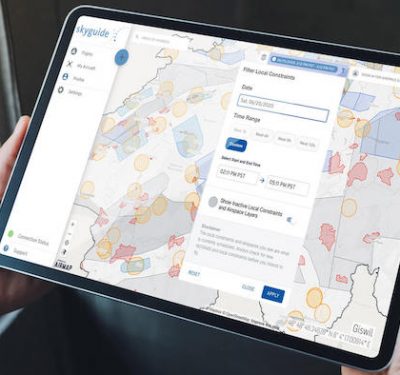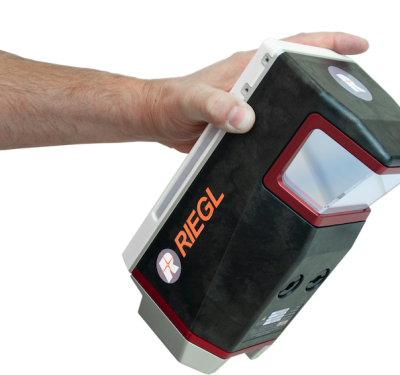
Trends were on exhibit at the recent CUAV Expo, along with numerous takeaways.
Emphasis on innovation and upgrades, data refinement, an expanding drone delivery market, a spotlight on U.S. airspace regulation alongside an increased international presence, and a focus on the future were among the trends apparent at the Commercial UAV Expo that was held from Sept. 6-8 at Caesar’s Forum in Las Vegas.
Two hundred thirty-two exhibitors and 3,405 verified attendees filled a sold out exhibit hall, keynote spaces and breakout rooms for presentations and workshops, and more than 300 attendees braved 100-degree heat to watch eight live pre-show demonstrations in nearby Henderson, Nevada. Attendance was up 74% over last year, and (almost) post-pandemic energy was palpable. “We surpassed our own expectations,” said Lee Corkhill, group event director for Diversified Communications, the show producer out of Portland, Maine.
Exhibits featured both product extensions and new offerings, going beyond drone manufacturers with software, components, services and accessories. “One of the bigger trends I noticed was how there was more variety in terms of the types of companies that were showcasing product,” said Jeremiah Karpowicz, group editorial director for Diversified. “In the past, I think the event floor was dominated by a few key players, especially on the hardware side.”
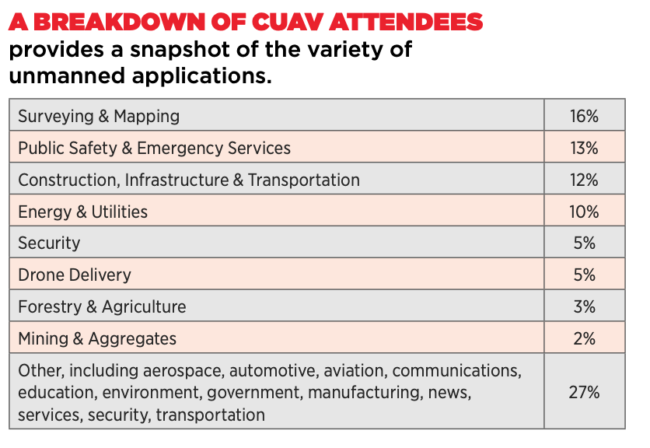
INNOVATION AND RE-CREATION
Innovation around new and existing products covered the show floor, including companies that added an integrated drone to their components rather than the other way around.
For example, Heerbrugg, Switzerland’s Leica Geosystems added a fully integrated drone to its BLK LiDAR line. “The Leica BLK2FLY is the world’s first autonomous flying laser scanner,” UAS Sales Manager Brian Baker said. “It utilizes multiple sensors, including LiDAR, imagery, GPS and radar for data collection, as well as advanced course obstacle avoidance software. The LiDAR data actually is fed into the flight controller, so the aircraft can not only detect but figure out the best path around or over an obstacle to continue collecting,” Baker said.
Sony AI was one of several companies representing the continued growth of artificial intelligence. With its U.S. headquarters in San Diego, the Sony subsidiary featured the Sony Airspeak S1 Professional Drone. Introduced two years ago with the aim of providing movie industry clients with a drone that could accommodate its full array of camera bodies and lenses, Sony AI has discovered an unexpected market. To its surprise, said Daniel Roe, who does business development for the company, the fact that pilots could control camera functions as well as the drone has proved attractive to utility companies and others that carry out inspections.
Similarly, Amprius Technologies of Fremont, California, presented its still-innovative batteries, which nearly double the energy density of lithium-ion batteries by using silicon instead of the more common graphite. Ronnie Tao, vice-president business development, explained that while silicon has long been the holy grail of battery manufacturers, only Amprius had a proprietary process to control the tendency of silicon to swell.

UPGRADES
Many exhibitors offered upgrades to existing products.
Robert Schumann, CEO of Harrisonburg and Reston, Virginia-based Blue Vigil, described on an Inside Unmanned Systems livestream how the company has added lights to its tethers. This additional illumination can aid those who must work in the dark during, say, a security situation. The lights from above also avoid shadows, which can be dangerous on construction and other sites.
Harris Aerial, out of Casselberry, Florida, talked about its new EFI system, gas tank and battery rack for its flagship Carrier H6 hybrid drone. Ethan Wash, director of engineering, said the EFi system eliminates the need for tuning, the gas tank is lighter and the battery rack allows instantaneous swapping of batteries.
Skyfront, based in Redwood City, California, promoted its newest hybrid UAV, the Perimeter 8. The drone offers an upgraded engine, which is more efficient and can carry more payload, according to Hemant Chaudhary, mechanical and controls engineer. The upgraded engine can climb to 12,000 feet and features an eight-rotor hybrid-electric system.
BETTER DATA
While many exhibitors were traditional drone manufacturers, supporting products such as new software peppered the floor. Consortiq, headquartered at London’s Heathrow Airport with a U.S. hub in Annapolis, Maryland, provides drone-based service packages that can include digital asset modeling, infrastructure inspections, mapping and surveying, and methane detection.
“What’s new is we’re supplying a full suite of data for digital asset management systems,” said Brian Grant, sales director for the Americas, explaining that its data provision has expanded from RGB images to thermal and LiDAR. “We’re also using terrestrial-based radar, laser systems and 360-degree cameras on the ground. So now, when you look at a facility it’s not just the drone shot from above but there is data from below or inside.”
Underscoring the company’s ability to make a good impression, Consortiq was a co-winner at the annual “Pitch the Press” competition for new products, with judges citing its use of AI and 360-degree cameras to provide that full data suite (this magazine’s executive editor was one of the judges).
On its part, Madison, Alabama-based GeoCue Group introduced the TrueView 655/660 with a third, nadir camera providing overlapping images, said Chad Dillard, manager direct sales North America. GeoCue also spotlit its LP360 Drone LiDAR Data Processing software, which can create and manipulate point cloud data directly from LAS files without time-consuming importing or converting processes.
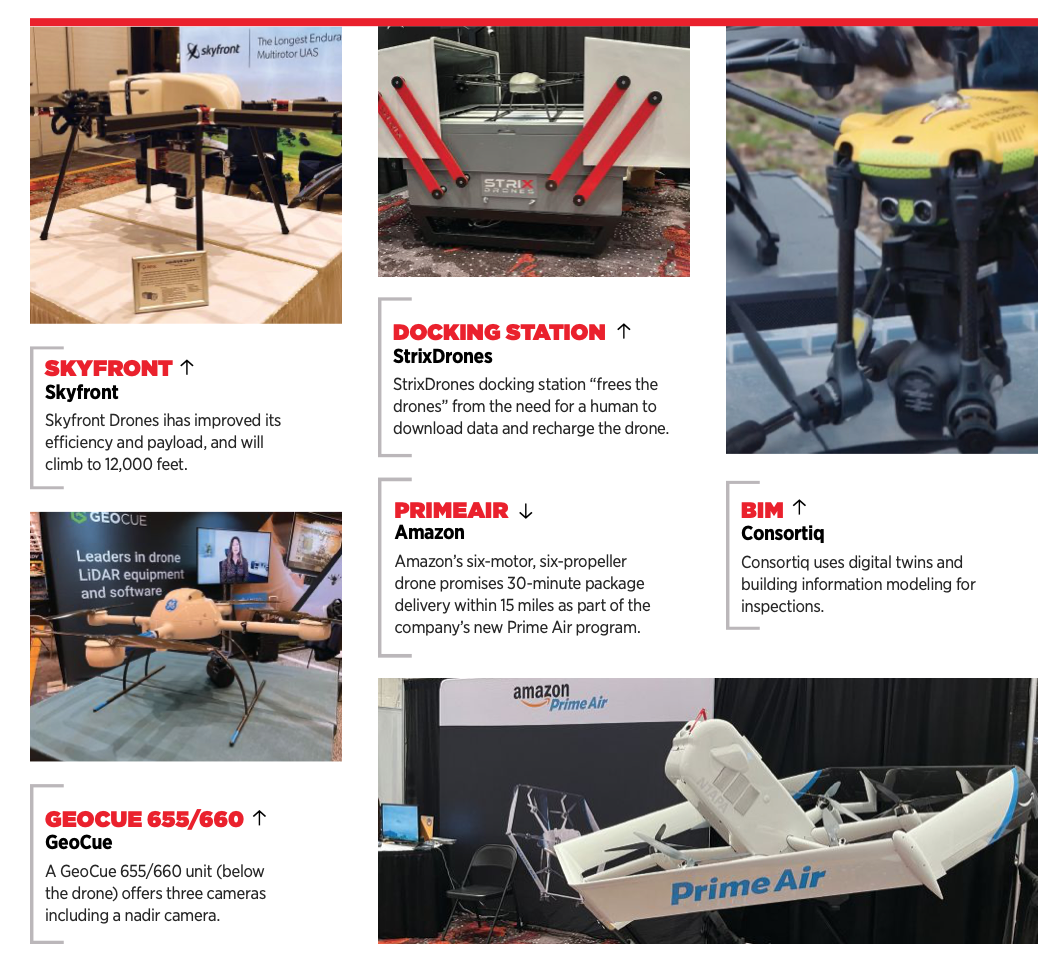
DRONE DELIVERY
Anticipated ongoing growth in drone delivery is a hot topic, and some big news came from Mountain View, California-based Matternet’s M2 Drone Delivery System. The company announced becoming the first firm to achieve FAA Type Certification for the U.S. This completed a four-year process with the agency, though the urban drone delivery company has been authorized for commercial BVLOS operations in Switzerland since 2017.
A keynote devoted to “The Future of Drone Delivery” involved representatives from Matternet, Alphabet’s Wing subsidiary, DroneUp and Amazon talking about their programs. Session chair Jay Merkle, executive director of the FAA’s UAS Integration Office, commented on the diversity of the represented solutions: “We’ve got everything [on the panel] from a 10-pound bicycle helmet foam drone [Wing] to an 80-pound drone [Amazon Prime Air],” but added that all the companies had a common operational thread. “I think the thing that strikes me is everyone is-hyper-focused on safety,” he said. “It takes a tremendous amount of autonomy to achieve that safety and manage the overall flight versus just controlling the drone.”
On the floor, Amazon showed off its six-motor, six-propeller drone, promising 30-minute package delivery within 15 miles. The drone, part of the company’s new Prime Air program, is able to take off vertically, fly horizontally and drop its cargo from three to four meters in the air, said Eric Berlinberg, lead program manager.
REGULATORY ENVIRONMENT
All eyes were on the FAA, either as a help or hindrance to developing products. “I think the FAA is one of the favorite punching bags,” Skydio CEO Adam Bry said, “but the overall theme has the FAA moving forward with programs like the FAA Beyond Program. These are really excellent programs that help steer the path toward the future.”
In his keynote, David Boulter, the FAA’s acting associate administrator for aviation safety, noted that at the FAA, “We’ve really learned a lot from the exemption and waiver process. Sometimes you have to get there step by step. I’d like to see us take more frequent smaller steps so that we can keep moving the ball forward.” As the FAA is streamlining its processes, “We ask, ‘How can we make this easier?’
“We’re one step closer to routine package delivery by issuing the first type certificate for drones,” Boulter said, referring to Matternet’s achievement. “We owe you a path regarding the exemption and waiver process,” he noted. “At the end of the day, we have two requirements. Safety is always our North Star. The second requirement is that we need to be responsive to those who have business before us. He encouraged those in the industry to come to the FAA with their concerns and suggestions. “I want practical approaches,” he said.
The FAA is “trying to blend doing things the same day with an approach that plays out over years… We can have safety and delivery.”
Asked about the September 16, 2022 implementation date for Remote ID, Boulter said that, for manufacturers, the FAA would use “enforcement discretion” through December 22 and work with those who are showing progress. “We don’t have any intent of changing the implementation date for operators,” he added.
INTERNATIONAL PARTICIPATION
With visas more available as COVID restrictions relax, attendees hailed from 45 countries and 48 U.S. states. A popular stop at the conference was the oversized international map, where attendees could place a pin representing their country or state of origin. Israel and Germany featured innovative products; a Czech Republic pavilion hosted five companies and a Korean amalgamation brought six. Products ranged from a drone-agnostic docking station from Israel/Florida-based StrixDrones to AI-focused inspection and maintenance solutions by Nearthlab, of Seoul.
Niv Aharoni, StrixDrones’ founder and CEO, showed off a full-sized model of the Dronedrop 1600 (there is a larger 2100) agnostic docking station, where packages can be landed or lowered into a unit with a unique drawer for each customer, who is then alerted via an app. A door closes above it, a cross-hatch system holds it in place, and recharging and downloading is automatic.
“Someone needs to free the drones!” Aharoni, said, noting the StrixDrones fills a missing piece in the drone mission lifecycle. After landing many drones, someone has to recharge them, download data and tend to other tasks, he said, “so the drone is autonomous, but it isn’t free.”
ALLIANCES
My-Linh Truong, division manager for unmanned laser scanning at leading LiDAR specialist Riegl USA, noted how the company was reaching out to platform manufacturers to grow its UAV Affiliate Program. “All of our sensors are platform agnostic,” she said, “and we do work with a variety of small and vetted drone manufacturers, all of whom are here on the floor at Commercial. Riegl is affiliating with these manufacturers, who provide quality platforms to fly our sensors.”
AN EYE TO THE FUTURE
“With the commercial UAV industry, we’ve really seen how well it’s grown,” Truong said. From her perspective, “the emphasis is on miniaturization and optimization.” Riegl, she added, is readying its offerings for an expanded-BVLOS world—longer flights on larger platforms.
Skydio’s Bry debunked an oft-cited industry limiter: the need for expert pilots. “This transition doesn’t make drone experts obsolete,” he said, foreseeing more reliance on software, and therefore on different types of experts. Computer experts are “10 times” more valuable today than they were 40 or 50 years ago because of computer proliferation,” he noted.
Bry predicted a similar pattern in the drone industry. “We’re largely automating everything that can be automated from a process or procedural perspective.” he said. Jobs, he suggested, can be transitioned from “mind-numbing” to positions “where they’re taught to think. Or you can put them in a job where they’re taught to create.”
Coincident to Bry’s focus on the future, the University Pavilion featured six schools with programs that support the drone industry, while the Genius NY Pavilion featured programs and corporate participants that are in a business accelerator competition for uncrewed systems, Internet of Things and robotics startups.
After the Expo, Diversified’s Karpowicz pointed to a maturation of the market. People aren’t coming to the event to be sold on the technology itself, he said, “but to understand how it can make a difference for them.”


